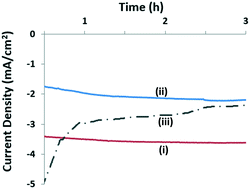Synergistic amplification of catalytic hydrogen generation by a thin-film conducting polymer composite†
Abstract
This work reports a composite of poly(3,4-ethylenedioxythiophene) (PEDOT) that is notably more catalytically active for hydrogen generation than the industry-standard benchmark catalyst, Pt, under the same conditions. A PEDOT thin-film containing nanoparticulate Ni (nano-Ni) and reduced graphene oxide (rGO) in the specific molar ratio of 5.6 (C; PEDOT) : 1 (Ni) : 5.2 (C; other), (photo)catalytically generated H2 at 3.6 mA cm−2 (including ca. 0.2 mA cm−2 due to the light illumination) after 3 h at −0.75 V (vs. Ag/AgCl) in 0.05 M H2SO4/0.2 M Na2SO4 under 0.25 sun. A control nano-Ni/rGO film containing the same quantities of nano-Ni and rGO but without any PEDOT, yielded 2.1 mA cm−2, indicating that the PEDOT synergistically amplified the above result by 71%. Other ratios of the above PEDOT composite produced notably lower activities. Control PEDOT, PEDOT/nano-Ni, and PEDOT/rGO films were an order of magnitude less catalytically active. A control bare Pt electrode produced only 2.2 mA cm−2 under the same conditions. Studies suggested the origin of the synergistic amplification to involve the PEDOT electrically connecting the largest number of active sites by the shortest, most efficient pathways for hole transport. These results confirm the proposition that thin-film conducting polymers involving very specific, optimum ratios of catalyst density to thickness may synergistically amplify catalysis.



 Please wait while we load your content...
Please wait while we load your content...